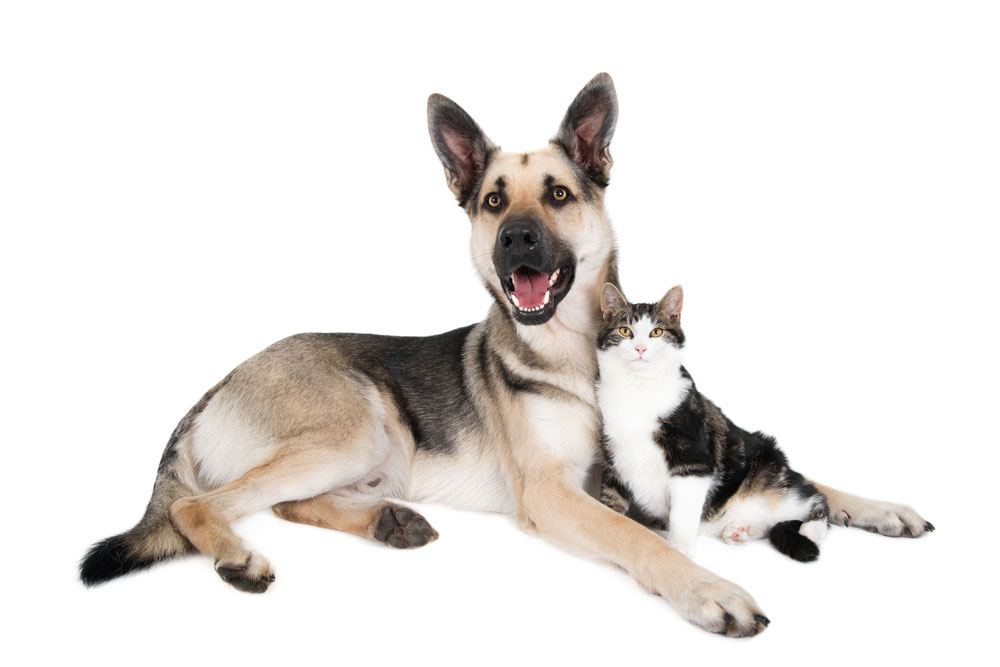Cats and dogs are among the most popular pets worldwide, each with their own unique traits and characteristics. Many people wonder if German Shepherds, known for their intelligence and loyalty, can coexist harmoniously with cats.
In this article, we will explore the compatibility between German Shepherds and cats, factors to consider before introducing them, and provide valuable insights and tips for fostering a positive relationship.
Table of Contents
Understanding German Shepherds
German Shepherds are a versatile and highly trainable breed. Known for their protective nature and loyalty, they are often used in roles such as police or military work, search and rescue operations, and as service animals.
German Shepherds are intelligent, active, and require regular mental and physical stimulation.
Understanding Cats
Cats are independent and often exhibit a more solitary nature compared to dogs. They are known for their agility, grace, and unique communication styles. Cats can be highly territorial and may take time to adjust to new environments or companions.
Are German Shepherds Good With Cats?
The compatibility between German Shepherds and cats can vary depending on several factors. While some German Shepherds and cats form close bonds and live harmoniously together, others may have difficulties coexisting.
It’s essential to consider the following factors when assessing the potential for a successful relationship:
- Temperament: German Shepherds with a calm and sociable temperament are more likely to get along with cats.
- Socialization: Early and positive exposure to cats during the critical socialization period can increase the chances of compatibility.
- Previous Experiences: German Shepherds with prior positive experiences with cats are more likely to be tolerant and accepting.
- Cat’s Personality: The personality and temperament of the cat play a significant role in the compatibility with German Shepherds.
Factors to Consider
Before introducing a German Shepherd to a cat, there are important factors to consider to ensure the safety and well-being of both pets:
- Size and Strength: German Shepherds are typically larger and stronger than cats, so their interactions need to be carefully supervised.
- Prey Drive: German Shepherds have a natural prey drive, which can pose a risk to smaller animals like cats. Precautions must be taken to manage this instinct.
- Health and Age: The health and age of both the German Shepherd and the cat can impact their ability to adapt and tolerate each other.
- Individual Personalities: Each animal has its own personality, and their compatibility should be evaluated on an individual basis.
Proper Introduction
Introducing a German Shepherd to a cat should be done gradually and in a controlled manner. Adhere to these suggestions for maximizing the likelihood of a fruitful commencement:
- Separate Spaces: Initially, provide separate spaces for the German Shepherd and the cat to ensure a gradual and safe introduction.
- Scent Exchange: Allow the pets to become familiar with each other’s scents by exchanging bedding or using pheromone-based products.
- Visual Introduction: After a period of scent exchange, introduce the pets visually, using a baby gate or a pet enclosure.
- Supervised Interactions: Gradually allow supervised interactions between the German Shepherd and the cat while closely monitoring their behavior.
- Positive Reinforcement: Reward positive behavior and interactions between the German Shepherd and the cat with treats and praise.
Supervision and Training
Proper supervision is crucial when German Shepherds and cats are together. Additionally, both pets should receive appropriate training to ensure their safety and promote positive interactions. Consider the following:
- Leash Training: Train the German Shepherd to walk on a leash to have better control during interactions with the cat.
- Basic Commands: Teach basic commands such as “sit,” “stay,” and “leave it” to redirect the German Shepherd’s attention when necessary.
- Cat-Specific Training: Train the German Shepherd to respond positively to cues related to the cat, such as “leave the cat alone.”
- Positive Reinforcement: Use positive reinforcement techniques, such as treats and praise, to reward desired behavior.
Building Trust and Bonding
To foster a positive relationship between a German Shepherd and a cat, focus on building trust and promoting bonding:
- Gradual Exposure: Allow the German Shepherd and the cat to spend gradually increasing amounts of supervised time together.
- Positive Associations: Create positive associations by rewarding calm and friendly behavior with treats, attention, or play.
- Play Sessions: Encourage interactive play sessions between the German Shepherd and the cat using toys or games.
- Joint Activities: Engage both pets in joint activities, such as clicker training sessions or puzzle toys, to promote cooperation.
Socialization
Socialization plays a vital role in the successful integration of a German Shepherd and a cat. Consider the following socialization strategies:
- Positive Experiences: Expose the German Shepherd to various positive experiences with cats, such as controlled meetups with friendly cats.
- Desensitization Techniques: Gradually expose the German Shepherd to stimuli associated with cats, such as their scent or sound, to reduce reactivity.
- Reward-Based Training: Use reward-based training techniques to reinforce positive behavior and create positive associations with cats.
Cat-Friendly Environment
Creating a cat-friendly environment is essential to ensure the comfort and well-being of both the German Shepherd and the cat:
- Vertical Space: Provide vertical spaces, such as cat trees or shelves, where the cat can retreat and observe the surroundings.
- Hiding Places: Create hiding places, such as covered beds or enclosed spaces, where the cat can seek privacy and feel secure.
- Litter Box Accessibility: Ensure that the litter box is easily accessible to the cat while being in a safe and quiet location.
Signs of Compatibility
Certain signs indicate that a German Shepherd and a cat can get along and potentially form a harmonious relationship:
- Curiosity and Playfulness: Both the German Shepherd and the cat display curiosity and engage in playful behaviors with each other.
- Relaxed Body Language: Both pets exhibit relaxed body language, such as loose muscles, wagging tails (for the German Shepherd), or gentle purring (for the cat).
- Non-Threatening Interactions: The German Shepherd and the cat approach each other without aggression or fear, showing mutual interest.
Signs of Incompatibility
Some indicators may suggest challenges in the compatibility between a German Shepherd and a cat:
- Aggressive Behavior: Aggressive behavior from either the German Shepherd or the cat, such as growling, hissing, or lunging.
- Excessive Fear or Anxiety: The cat shows excessive fear or anxiety in the presence of the German Shepherd or vice versa.
- Persistent Avoidance: The German Shepherd and the cat consistently avoid each other and show no interest in interaction.
Addressing Challenges
If challenges arise in the relationship between a German Shepherd and a cat, it’s crucial to address them promptly and effectively:
- Professional Guidance: Seek advice from a professional animal behaviorist or trainer experienced in managing inter-pet relationships.
- Gradual Reintroduction: Consider a gradual reintroduction process, following the initial introduction guidelines but with additional caution and guidance.
- Separation and Management: If necessary, separate the German Shepherd and the cat while implementing management strategies, such as baby gates or designated pet zones.
Training German Shepherds
Proper training for German Shepherds is crucial to ensure their behavior is compatible with living alongside cats:
- Basic Obedience Training: Train the German Shepherd to respond to basic commands such as “sit,” “stay,” and “come” consistently.
- Leash Training: Teach the German Shepherd to walk calmly on a leash to maintain control during interactions with the cat.
- Socialization Exercises: Introduce the German Shepherd to a variety of stimuli, including cats, in controlled and positive environments.
Cat Behavior Understanding
Understanding cat behavior is essential for successfully integrating a German Shepherd and a cat:
- Body Language: Learn to interpret a cat’s body language, such as tail position, ear posture, and vocalizations, to gauge their comfort level.
- Personal Space: Respect the cat’s need for personal space and provide opportunities for solitude when desired.
- Play and Hunting Behavior: Engage in interactive play sessions with the cat to satisfy their natural hunting instincts and provide mental stimulation.
Cat-Friendly Spaces
Creating designated cat-friendly spaces is beneficial for both the cat and the German Shepherd:
- Vertical Space: Install cat trees or shelves that allow the cat to retreat to higher areas and observe the surroundings.
- Cozy Hideaways: Provide covered beds or enclosed spaces where the cat can relax and feel safe.
- Scratching Posts: Offer appropriate scratching surfaces to fulfill the cat’s natural scratching behavior and protect furniture.
Establishing Boundaries
Setting boundaries is crucial to ensure mutual respect and prevent potential conflicts:
- Protected Spaces: Create separate areas where the cat can retreat without being disturbed by the German Shepherd.
- Mealtime Separation: Feed the German Shepherd and the cat in separate areas to avoid resource guarding or competition.
- Supervised Interactions: Monitor the interactions between the German Shepherd and the cat to ensure respectful behavior and intervene if necessary.
Positive Reinforcement
Positive reinforcement techniques are effective in shaping desired behavior and creating a positive environment:
- Rewards: Use treats, praise, or toys to reward the German Shepherd and the cat for calm, friendly, and appropriate behavior.
- Clicker Training: Incorporate clicker training to reinforce positive behaviors and establish clear communication with the German Shepherd.
- Consistency: Consistently reward the desired behavior every time it occurs. This helps the German Shepherd and the cat understand what behavior is being reinforced and encourages them to repeat it.
- Timing: Ensure that the reward is given immediately after the desired behavior is exhibited. This helps the German Shepherd and the cat associate the reward with the specific behavior they just performed.
- Incremental Steps: Break down complex behaviors into smaller achievable steps. Reward the German Shepherd and the cat for each step they successfully complete, gradually leading them towards the desired behavior.
Handling Aggression
Addressing aggression promptly and effectively is crucial for a harmonious relationship:
- Professional Assistance: Consult with a professional animal behaviorist or trainer experienced in aggression management.
- Behavior Modification: Implement behavior modification techniques tailored to address the specific aggressive behavior displayed.
- Safety Measures: Ensure the safety of both the German Shepherd and the cat by using muzzles, barriers, or other safety equipment as recommended by professionals.
Separation Strategies
In certain situations, separation between the German Shepherd and the cat may be necessary:
- Time Apart: Allow periods of separation to provide the cat with uninterrupted time to relax or engage in independent activities.
- Gated Areas: Use baby gates or pet enclosures to create physical barriers that prevent direct contact between the German Shepherd and the cat.
- Supervised Separation: If necessary, supervise the German Shepherd and the cat in separate spaces to ensure their safety and prevent conflicts.
Monitoring and Adjustment
The process of introducing a German Shepherd and a cat requires ongoing monitoring and potential adjustments:
- Observation: Continuously observe the interactions between the German Shepherd and the cat for any signs of discomfort or conflicts.
- Evaluation: Assess the progress and overall dynamics between the pets regularly, adjusting the management strategies as needed.
- Professional Guidance: Seek professional guidance if challenges persist or new issues arise during the integration process.
Common Misconceptions
Several common misconceptions exist regarding the compatibility of German Shepherds and cats. Let’s debunk some of them:
- German Shepherds Are Naturally Aggressive Towards Cats: While some German Shepherds may display aggression towards cats, it is not an inherent trait of the breed. Proper training, socialization, and management can foster compatibility.
- Cats Cannot Coexist With Large Dogs: Cats and large dogs can form successful relationships with the right introductions, training, and ongoing management.
- All German Shepherds Have a Strong Prey Drive: While German Shepherds have a natural prey drive, it can be managed through training and proper socialization.
Case Studies
Real-life examples can provide valuable insights into successful German Shepherd and cat relationships. Here are a few case studies:
- Case Study 1: Luna, a German Shepherd, and Oliver, a cat, have been living together for three years, forming a close bond through gradual introductions, positive reinforcement, and ongoing training.
- Case Study 2: Max, a German Shepherd, initially displayed aggression towards cats but, with the help of professional behavior modification techniques and patient introductions, successfully coexists with a rescued cat named Lily.
FAQ 1: Can German Shepherds be trusted with cats?
Yes, German Shepherds can interact safely with cats, but it depends on the individual dog’s temperament, socialization, and training. Proper introductions and ongoing supervision are crucial to ensure a positive relationship.
FAQ 2: Are German Shepherds more likely to chase or harm cats?
German Shepherds have a natural prey drive, which may make them more inclined to chase small animals like cats. However, with proper training, socialization, and supervision, many German Shepherds can coexist peacefully with cats.
FAQ 3: How can I introduce a German Shepherd to my cat?
To introduce a German Shepherd to a cat, start with separate spaces and gradually introduce their scents through bedding or pheromone-based products. Proceed with visual introductions using a baby gate or pet enclosure, and gradually allow supervised interactions while closely monitoring their behavior.
FAQ 4: What signs indicate that my German Shepherd and cat are getting along?
Signs of compatibility include curiosity and playfulness between the German Shepherd and the cat, relaxed body language, and non-threatening interactions. If both pets show interest in each other without aggression or fear, it’s a positive indication.
FAQ 5: How long does it take for a German Shepherd and a cat to get along?
The time it takes for a German Shepherd and a cat to get along can vary. Some may develop a bond quickly, while others may require more time and patience. It’s important to allow them to progress at their own pace and provide positive reinforcement for calm and friendly behavior.
FAQ 6: Can I leave my German Shepherd and cat alone together?
Leaving a German Shepherd and a cat alone together depends on their level of compatibility, trust, and training. It’s generally recommended to gradually increase the amount of supervised time they spend together and ensure a safe environment for both pets.
FAQ 7: What should I do if my German Shepherd shows aggression towards my cat?
If your German Shepherd displays aggression towards your cat, it’s important to seek professional guidance from an animal behaviorist or trainer experienced in aggression management. They can assess the situation, provide tailored strategies, and help you modify the behavior effectively.
FAQ 8: Can a German Shepherd and a cat become best friends?
Yes, a German Shepherd and a cat can develop a strong bond and become best friends. With proper introductions, socialization, and positive reinforcement, many German Shepherds and cats have formed lifelong companionships.
FAQ 9: How can I prevent my German Shepherd from chasing my cat?
Preventing your German Shepherd from chasing your cat requires training, management, and redirection techniques. Teaching commands like “leave it” and providing mental and physical stimulation can help redirect their focus and prevent chasing behavior.
FAQ 10: Are German Shepherds good with other pets besides cats?
German Shepherds can generally adapt well to living with other pets, such as dogs of different breeds, if they are properly socialized and trained. However, individual personalities and temperaments play a significant role in determining compatibility with other animals.
Conclusion
The compatibility between German Shepherds and cats depends on various factors such as temperament, socialization, and training.
While some German Shepherds and cats can develop a harmonious relationship, it’s essential to introduce them gradually, provide proper supervision, and address any challenges that may arise.
Remember that each German Shepherd and cat is unique, so it’s important to assess their individual personalities and needs. By following the guidelines provided in this article, you can increase the chances of a successful integration and create a safe and loving environment for both pets.

I’m David, an expert contributor and writer, with two furry friends of my own, I know the challenges of raising and caring for dogs. From training to nutrition and health, my goal is to provide valuable insights and advice to help create strong bonds and happy, healthy lives. Find me in Twitter.




